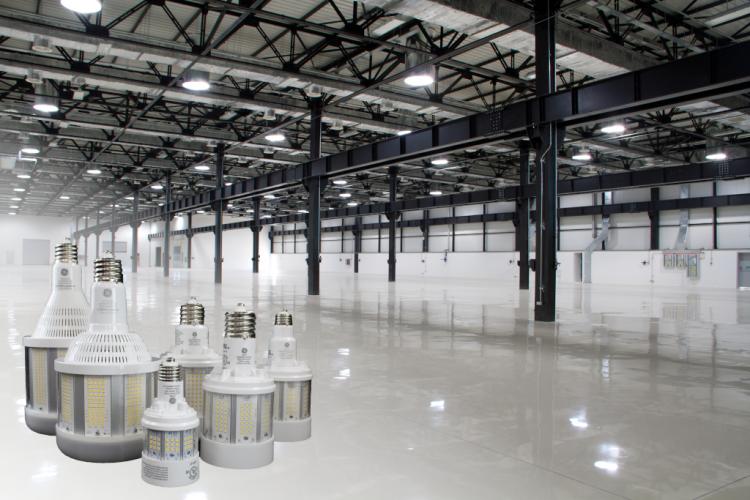Find Savings HIDden in Plain Sight
Find Savings HIDden in Plain Sight
Find Savings HIDden in Plain Sight
Discover the Compelling Case for LED Replacements in High Bay HID Applications
When it comes to lighting in high bay commercial applications, high intensity discharge (HID) lamps have been the go-to technology for some time. These lamps create the intense illumination needed to bathe large areas in light, and they have generally performed their job well… with a few drawbacks.
HID lamps, while capable of producing high lumen output, can be prone to lumen deterioration over the course of their lifespans. As they age, HID lamps can also experience cycling, where increasing voltage requirements to maintain arc discharge exceeds what the ballast can provide, causing lamps to turn on and off repeatedly. Fading of beams and subsequent color shifts can also occur as HID lamps age, and built-in filters that prevent exposure to UV rays can degrade over time. Aging aside, HID lamps sometimes rely on toxic materials like mercury or small quantities of radioactive materials to function, creating disposal challenges.
Many people have learned to overlook the drawbacks of HID technology out of a need to easily illuminate broad areas. Now, however, there is a better option available that provides similar lumen output while lasting far longer, operating much more efficiently and providing advanced reliability. This way forward, many are finding, lies with LED technology—in this case, 165W LED lamps developed by Current, to replace 400W HID lamps in high bay applications.
Why Switch to LEDs?
There are a number of reasons to move from HID to LED technology. First of all, LED replacements for HIDs are not subject to many of the challenges inherent to arc lamp design, from cycling to fading to lumen deterioration. These challenges aside, though, LEDs beat HID lamps in a head-to-head competition by just about any standard.
1 | They're Extremely Efficient

While the upfront cost may be higher for an LED lamp than an HID lamp meant for high bay lighting applications, using LEDs can save you substantially on costs over the course of the lamp’s life. Consider, for instance, that a standard HID lamp may require 400W to operate, as well as a 60W ballast to supply power. An LED replacement that provides similar lumen output, however, requires only 165W and relies on a 35W ballast for energy. The result is a savings of more than 50 percent on energy consumption alone. At a cost of $0.11 per kWh, that’s a savings of $1,430 simply on energy costs over the 50,000-hour L70 life of each 400W HID lamp you replace with our LED lamp.
Think of how that savings could add up across a large facility. With an industry-leading total system output of 100 lumens per watt (LPW) or more, HID-replacing LED lamps built by Current, mean quality illumination at a low total cost of ownership.
2 | They Last

With a 50,000-hour L70 rating, LED lamps for high bay applications last 2.5 times longer than the HID lamps they replace. While only having to change two LED lamps for every five HID lamps that expire is a nice benefit in any scenario, in high bay applications, the longevity of LEDs matters even more. It means less climbing tall ladders, fewer rides on lift trucks and avoiding disruption of activity below extinguished lights. With LEDs, maintenance costs and downtime are reduced, especially when those LEDs are constructed by a trusted lighting brand with a long history of reliability.
3 | They’re Easy to Manage

One of the best things about LED replacements for high bay HID applications is their simple installation and compatibility. LED replacement lamps screw right into existing fixtures and work with most existing ballasts*, requiring no additional wiring or complicated conversions, and each lamp comes with a tether kit. Unlike HIDs, LED replacement lamps feature a universal burn position and have no complex disposal requirements, as they feature no lead or mercury and comply with all RoHS requirements.
* A list of compatible ballasts can be found here
4 | They Look Great

While some HID lamps are often seen as energy efficient compared to some other lighting technologies, this energy efficiency often comes at a substantial cost to color-rendering ability. We have all seen the golden monochromatic hue of a high pressure sodium street light lamp, for example. With LEDs, however, you get peak energy efficiency and compelling aesthetics. LED replacements for 400W HID lamps are available with a CRI of 73, as well as color temperatures of 4000K and 5000K. Unlike HIDs and some fluorescent lighting technologies, LEDs also provide instant-on full brightness, requiring no warmup time for immediate high-quality illumination.
Why Switch to These LEDs?
The case to convert your high bay-installed HIDs to LEDs is not one in which it is particularly hard to reach a verdict: LEDs are the clear winner. How should you choose which LED replacements are right for you, though? There are many options on the market, but very few are currently developed by well-established lighting companies with extensive records of reliability. The LED replacements for HID applications offered by Current, come with one of the highest LPW outputs on the market, an included lamp tether kit and a five-year limited warranty. You can use the same reliable, efficient LED technology replacing HIDs in your high bay applications for a variety of outdoor and enclosed applications, too.
Where Do You Go From Here?
A quick and sure way to significantly reduce energy and maintenance costs while boosting reliability is through LED replacement options for your commercial HID applications. The fixtures may hang high above, but thousands of dollars in savings are easily within reach.
Want to discover how much you could save in total? Contact the experts from Current.

